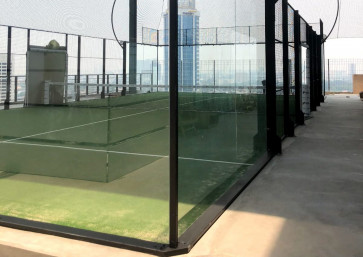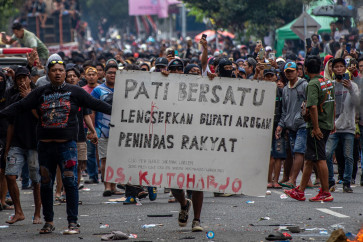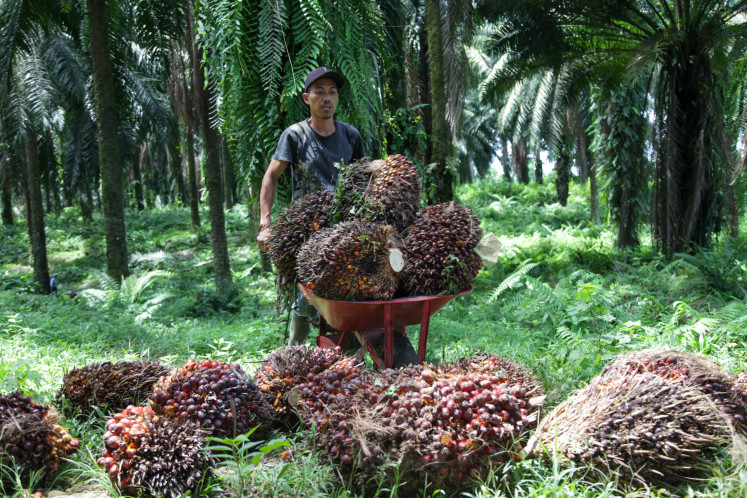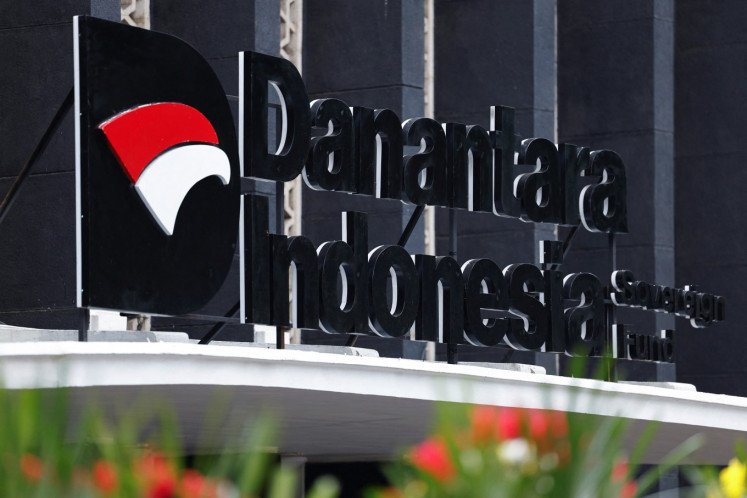Popular Reads
Top Results
Can't find what you're looking for?
View all search resultsPopular Reads
Top Results
Can't find what you're looking for?
View all search resultsRefugees offered hope, empowerment in camps
Under the sun: A Rohingya woman (with umbrella) takes her baby on a walk around the Kutupalong refugee camp in Cox’s Bazar, Ukhiya, Bangladesh
Change text size
Gift Premium Articles
to Anyone
U
nder the sun: A Rohingya woman (with umbrella) takes her baby on a walk around the Kutupalong refugee camp in Cox’s Bazar, Ukhiya, Bangladesh. Kutupalong, one of the world’s largest refugee camps, hosts over 600,000 Rohingya refugees.
Political turbulence and an uncertain security environment have led these particular people to flee their homes and settle in foreign countries — either temporarily or permanently. Their status as refugees has made them eligible for international financial assistance. Yet, there is far from enough for them to live decent lives. The Jakarta Post’s Nurni Sulaiman was among 11 international journalists recently invited to participate in a three-week program by the East-West Center, which included visits to a Rohingya refugee camp in Cox’s Bazar, Bangladesh, and a Syrian refugee site in Istanbul, Turkey. An abstract of her report of the program is today’s Reportage.
In a temporary unfloored building made of bamboo, dozens of Rohingya women and girls were chattering and joking together. Wearing Muslim clothes, along with hijab and niqab, they were struggling tirelessly to improve their sewing skills.
The modest property, known as the Women’s Learning Center, is situated at Block F of Camp 4 in the Kutupalong Refugee Camp in Cox’s Bazar, Ukhiya, Bangladesh. The Kutupalong camp is the largest Rohingya refugee camp in the world.
Hadidjah, one of the refugees in the camp, said the Bangladeshi government and international organizations and people had been providing them with food and necessities. However, women have special needs, more than the basics. That’s why they need to go out to make money.
“There are certain items that women need to have, such as cosmetics,” she told The Jakarta Post in an interview on Sept. 17. “That’s why we learn to sew here so that we can earn money from the uniforms we produce.”
Hadidjah was thankful for the presence of the center as it has contributed not only to women’s empowerment economically, but also to their self-confidence. She recalled when a girlfriend of hers was harassed by men when she was going out of the center.
“This friend of mine told the sewing workshop participants about the case. Later on, five to 10 girls of the center looked for the men and threatened to report them to the CIC [Camp in Charge]. There has been no such harassment since then,” said Hadidjah.
The Women’s Learning Center and the sewing workshop were organized by OBAT Helpers, a nonprofit social organization serving displaced and disadvantaged individuals in Bangladesh by providing them access to education, health care, infrastructure and empowerment initiatives while ensuring sustainable community development.
OBAT Helpers, in cooperation with a local organization, the Prantic Unnayan Society in Cox’s Bazar, and funding from the HOPE International Development Agency of Canada, has established three sewing centers in an effort to provide the women refugees with vocational training and economic empowerment.
AFM Rezaul Karim, executive director of the Prantic Unnayan Society, said 58 sewing machines had been made available for the sewing workshop program. The program itself was organized by the Rohingya Women and Girl’s Empowerment Association (RWGEA), a committee consisting of Rohingya women.
At the sewing center, participants are taught to produce uniforms for boys and girls. One dress produced is priced at 100 Bangladesh taka (US$1.18) and each participant earns 65 taka for one dress produced. Another 25 taka is calculated as the cost of production per unit and the remaining 10 taka go to the association.
Apart from sewing workshop, OBAT Helpers said it intends to broaden the project to include handicraft training for women, which is aimed at providing the Rohingya women with the skills necessary to produce textile products, handicrafts and other tailor-made products to sell in marketplaces.
Karim said all the trainers and the staff were female so the participants would feel very comfortable discussing and resolving their own problems with them.
Learning center: Rohingya refugees sit in a circle at a sewing workshop organized by OBAT Helpers, a nonprofit social organization serving displaced and disadvantaged individuals in Bangladesh, in cooperation with local organization the Prantic Unnayan Society and the HOPE International Development Agency of Canada. The workshop was held to provide the women with vocational training and economic empowerment.At least 500 Rohingya women are to benefit from the project at its completion. The women are expected to be well-established in tailoring and handicraft production and able to work on their own after the course.
As the female refugees have been provided with sewing workshop as part of their empowerment program, male refugees have been trained to get involved in the construction of bamboo shelters for the refugees themselves. As the urgent demand for bamboo for shelters is outpacing the supply, which thus puts enormous pressure on the local environment, efforts to replant the bamboo trees are being made on a large scale.
The first large bamboo treatment plant, also involving the male refugees, was introduced in Cox’s Bazar in November 2018. The scheme is expected to increase the lifespan of bamboo that has been used for load-bearing support in the refugee shelters.
As for children, the OBAT Helpers has been establishing the Digital Learning Center, in cooperation with the Teach the World Foundation. In the Digital Learning Pilot Class, children study English, mathematics, the Burmese language and social and emotional learning (SEL).
A total of 26 temporary learning centers (TLCs) have been established in order to accommodate the digital learning process. Class sessions are two hours long, allowing up to 90 children to attend class in a single TLC daily.
Students also receive nutritional snacks each day in class. There are currently 2,320 students enrolled in OBAT’s TLCs — 1,098 girls and 1,222 boys.
In addition to normal class days, the TLCs have held activity sessions for the benefit of the children. These include a celebration of International Education Day, as well as Global Hand Washing Day and a hygiene training session, where children are taught how to properly wash their hands and brush their teeth.
OBAT Helpers is working toward the goal of building 100 learning centers, which would provide an education to 10,000 children.
The Kutupalong Refugee Camp in Cox’s Bazar is inhabited mostly by Rohingya Muslims who have fled from persecution in neighboring Myanmar. It is one of the two government-run camps in Cox’s Bazar, the other being the Nayapara Refugee Camp.
The Kutupalong Refugee Camp also refers to the makeshift camps that have sprung up adjacent to the government-operated camp, although these are not officially part of the camp. The original camp and the surrounding makeshift camps have grown to become the world’s largest refugee settlement with more than 600,000 people living in an area of just 13 square kilometers.
Amnesty International recorded that more than 750,000 Rohingya refugees fled from Myanmar and crossed into Bangladesh in August 2017. This country is the main destination because of its geographical proximity, which is adjacent to the land and hills. The refugees are mostly women and children.
The exodus of the Rohingyas happened after violence was carried out by the Myanmar military against the Muslim minority. During the period of displacement, their numbers had increased after those adults were married and had children. It is reported that more than 1 million people live in the camp at Cox’s Bazar.
Marin Din Kajdomcaj, the head of operations of the Cox’s Bazar sub-office of the United Nations High Commissioner for Refugees (UNHCR), said 2018 was the year when they mostly worked together building shelters and roads, establishing health and education infrastructure and stabilizing the land so that when the monsoons come there would be no flooding or landslides.
In 2018, the UN and the UNHCR moved about 2,000 individuals away from the risky and hazardous parts the hillsides in the area to a new extension camp.











